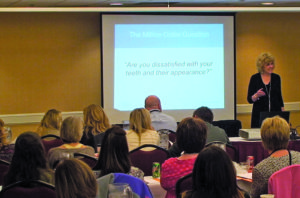
Creating Opportunities for Success.
Creating opportunity is taking action, which results in positive outcomes. Opportunities can be created by adopting behaviors that lead to being hired or promoted, or opening new doors for success. Regardless, the intended outcome is success. What it is not is fortuity—a lucky chance. Positive outcomes are not a coincidence. When you create an opportunity, you take advantage of a good situation to meet or exceed expectations. In my personal experience, the outcome was much more than I could have ever anticipated.
My Story
I was asked to write this article about creating positive opportunities in my own career. It’s not always easy writing about oneself; however, I agreed to try and include some examples.
My beginnings in the dental industry started in 1984, when I began work as a receptionist for a dentist in Fort Smith, Arkansas. I was always a motivated person, and on the first day, I decided that nobody was ever going to answer the phone any better than me. I was always going to do my best.
I had to figure out the things that worked for the dental practice by trial and error. At the time, it was a very small dental practice. My first opportunity was just being friendly on the phone. I thought it would be easy. I also thought, ‘I can easily schedule patients for appointments.’
However, it wasn’t as easy at it seemed (I don’t mean the friendliness part). I didn’t know that I should identify my office by announcing my name and saying, “This is Tawana. How may I help you?” Instead, I just said, “Dental office.” One day, a caller asked, “Are you the building? Are you the office?” I was so embarrassed! I said, “No, I’m Tawana.” On that day, I learned that there was a better way to answer the phones.
Getting Started
During the early days, our hygienist only worked two days a week, so I asked her why she didn’t work every day (which was about sixteen days a month). She said, “I don’t have enough patients. If we figure that out and get people in here, then I can work every day.”
As every dentist knows, you can’t just pay a hygienist, or anyone else for that matter, to show up without work to do—you must have patients. So the hygienist and I implemented a system that built up our hygiene clients until she was able to work every day.
That experience was an early taste of success. After that, I felt confident that we could succeed in the future, because I already had a small victory under my belt. Together, the hygienist and I had created something that didn’t exist, and we caused it to happen as a result of our actions. We implemented a recall system that I still believe in today. (For tips on setting up a recall system, see the article, “The Untapped Power of Your Recall System,” Aesthetic Dentistry, Spring 2015.)
Next Steps
After working six years for this dentist, Dr. Kendall Roberts bought the practice. When Dr. Roberts bought us out, I considered moving on to another career. At that point, I didn’t feel completely challenged. I’m a goal-oriented person and I wanted to create something. I didn’t understand the potential of dentistry.
The building where we worked was not large enough to accommodate two doctors and two hygienists, so we moved into a different building at a new location. At the time, I asked Dr. Roberts if I could be his office administrator and he agreed. There was no raise involved, however, I was moving forward.
In my new position, there were new challenges—issues I didn’t know anything about—such as last-minute cancellations, broken appointments, and high accounts receivable. I’ve come to learn that these are typical concerns in dental practices today.
To help out, Dr. Roberts sent me to a consultant. In response to the problem of patients not paying for their accounts, the consultant suggested, “Just smile and look patients in the eyes and ask, ‘Will that be cash, check, or credit card?’”
Unfortunately, that response didn’t always produce the desired result. Patients said, “Oh, I don’t ever carry a credit card.” Or, “I don’t have enough cash with me today.” Or, “My checkbook is in the truck. I’ll go get it.” And then I saw brake lights pulling out of the parking lot! There had to be a better way.
Our practice was struggling, and I was struggling too. However, I’m not one to give up. It’s never been my M.O. to quit when things are down. I thought, ‘I don’t know how, but we’re going to succeed.’ We tried so many things, it would just make your head swim, but unfortunately, we never stuck with anything.
In September of 1994, Dr. Roberts sent me to a front-office training seminar presented by Arrowhead Dental Laboratory and Dr. Dick Barnes. After that seminar, we immediately started to have success. The first thing I noticed (after doing it right for 60 days) was that patients were paying. Also, we didn’t have broken appointments anymore in the doctor’s schedule. It was the most amazing thing!
Make it Happen
When implementing a new structure into your practice, it helps to have a leader who believes in where he or she is going. In my circumstances, I felt like I couldn’t ask anybody to do anything that I was not willing to do first. It wasn’t that I was perfect; other people came along who could ultimately do a better job than I ever did in certain capacities. However, you can begin by saying, “Doctor, we’re not getting the results that we want. Let’s do this.” Why not? Try out the Dr. Dick Barnes structure for 60 days, because good habits will be formed during that time.
Dentists are typically looking for the next best thing, whether it’s clinical or in practice management. If they don’t get success quickly, they’ll move on. In Dr. Roberts’s office, I knew that if we did not get measurable successes early on, we would give up and not continue with this structure.
A key indicator that something needs to change (and the way to get a doctor on board with changing their current structure) is to take action when a dental practice is struggling. When it’s struggling, the team members know that something needs to be done.
At that time, it usually isn’t difficult to encourage doctors to make a change. They’ll be on board because they’ve been waiting for someone in their practice to take a new direction. At that point, the doctors realize that perhaps they can “just be the dentist,” as Dr. Dick Barnes suggests (which simply means that the team members are responsible for their own jobs and the dentist can focus on providing life-changing dentistry for the patients).
After we implemented this new structure, I continued to work for Dr. Roberts for nine more years. Positive changes happened and it was very rewarding. After that time, I became an employee of Arrowhead Dental Lab full-time as a practice development consultant. I left the dental practice not when things were down, but when things were up! When I discovered how dentistry could indeed change the lives of patients, it was exciting to think about doing it on a wider platform.
Confidence vs. Success
Today, in the dental practices that I train, I ask, “Which comes first, confidence or success?” When I ask that question, people are quick to say, “Oh, it’s confidence!” But actually, it is not—success comes first. When attempting to accomplish something that you’ve never done before, you won’t have confidence in it until you prove it. Success comes first.
To start implementing change, there’s no time like today! American industrialist Andrew Carnegie (1835–1919) said, “You cannot push anyone up the ladder unless he is willing to climb a little.” Along those same lines, in his book The Power of Leadership, leadership expert John C. Maxwell (1947–) wrote, “No one can succeed for you. Success isn’t a gift to be given away.”
Success is something that each individual must do. When I consult with dental offices, I look for someone who will rise to the occasion and say, “Let me do that. I know I can do that part.”
You can’t make people do what they don’t want to do. You can give them tasks, and often they’ll get the tasks done. However, to make a huge change—a fundamental paradigm shift—someone typically rises to the forefront and says, “Let me do that. I will make a difference, and I’ll be good at that one particular thing.”
At first, it may start with simple memorization. For example, when answering the phones (whether scheduling, confirming, or answering shopper calls), it’s good to memorize key phrases. (see my article, “Using the Words That Work,” Aesthetic Dentistry, Spring 2016.) Set a goal to get a certain amount of new patients through the door. You can’t just let those patients call your office and then hang up. That’s not serving the patient or building a good relationship.
It gives me great joy when offices call me to report their successes after a training. I want every office to be successful immediately—and I’ve seen it happen!
I recently received an email from an office just one week after I visited them. The email said, “Tawana, it’s been a great first week. We are all seeing success with the newfound verbiage, we have met with and started building relationships with several new patients, plus we are setting up diagnosis financial arrangement appointments to close on recommended treatment. Attached are the number of crowns and missing teeth that have come through hygiene appointments this week that you asked for. We are still going strong.” That’s success!
Did they believe me that all this would work? They wanted to believe it. They didn’t have the confidence early on. It’s very important to recognize when someone steps up and says, “Please let me be the person to make this happen.” Dr. Roberts gave me that same opportunity and it opened up additional opportunities for me throughout my career.
Focus on Urgent Tasks
It’s true that everything that you do in a dental practice is important. However, some things are more urgent than others. I was in an office a little while ago and an employee said, “I want to do what you suggest, but I’ve got to get all these other things done.” Setting priorities can be challenging.
I felt her pain. After I attended the Dr. Dick Barnes training for the first time, I met with my doctor and asked for permission to focus my energy on the urgent things, assuring him that I would get everything else done. I knew that if I couldn’t focus on the urgent matters, we would never see change.
You have to analyze what’s most important to your practice. Certain people are more task-oriented than problem-solvers; turn over more of the daily tasks to them. Then ask questions within your practice such as, “Who wants to get this job done?” Or, “Who is willing to cause something new to happen?”
I have witnessed this strategy succeed in offices—the team members separated the “urgent” tasks from the “important” ones and acted on those things first. Identifying and prioritizing the tasks in a dental office can make a real difference.
When describing job responsibilities, the words you use matter. Once, I a met an office manager who used these words: “I can’t get the girls motivated to answer the telephone. All they’ve got to do is just answer the phone.” I suggested that it’s not just answering the telephone. I said, “It is the first impression for anybody who calls the office.” Everybody wants to feel and know that what he or she does every day is important and can make a significant difference.
Overcome Roadblocks
Keep in mind that roadblocks sometimes turn up along the path to success, and some practices set up their own roadblocks. One of the biggest is procrastination. Dental offices should start implementing new strategies immediately—because otherwise it will never happen. Whenever I do a Total Team Training, I always give the office suggestions of things to begin working on immediately, so they have a starting point.
After the training, I call to check in on the practice’s progress. Sometimes I hear, “We’re going to have a staff meeting, and we’ll get this figured out later.” In one office, I revisited the practice after a year and they had not implemented any changes. They still had the same scheduling problems they had been struggling with on the initial training. The hygienists were frustrated and the office was wasting a lot of time by overbooking the doctors. Just start making changes today!
Often a roadblock is just a failure to begin. As Lucius Annaeus Seneca (5 BCE–65 CE), a Roman statesman, observed, “If a man knows not what harbor he seeks, any wind is the right wind.” You have to have a purpose. Life is not an accident. Somebody who creates their own opportunity makes things happen. When you encounter roadblocks, don’t panic. If the pressure is on, just keep on keeping on!
Small glitches are sometimes perceived as roadblocks. I have clients tell me that the structure didn’t work for them on a particular patient. I usually respond, “But that was one out of how many?” Instead of looking at the successes, they focus on the “one-percenter” who it perhaps didn’t work for.

Instead, focus on the positive. Don’t let one failure stifle you. At our dental practice, I was determined to succeed. I decided, “I won’t let any of those situations discourage me.” I told the doctor, “I called twenty people today. And I’m not looking at the three patients who I didn’t get scheduled, I’m looking at the seventeen patients who did.”
Don’t listen to the naysayers—just dwell on the successes! When doctors see your successes, they can’t help but say, “It does work!” The morning huddle is a great time to share some of your successes with the office. It’s important to let others know when changes are working.
Life-Changing Dentistry
My experience working in the dental industry has taught me that every person within the practice can have a significant part in changing the lives of patients through the world of dentistry. Years ago, Arrowhead asked me to speak to the technicians in the dental lab. I told them, “That case that you’re working on right now—it’s not just teeth. It’s not just veneers. It’s not just crowns. It’s somebody’s mother. It’s somebody’s wife. It’s somebody’s daughter. It’s somebody’s son. You are contributing to patients’ lives in such a positive way. Their lives are never going to be the same again because of you.”
As I mentioned earlier, life takes you in directions that you can’t even imagine sometimes. Before I started working in the dental industry, I dreamt of being a teacher. Today, as I look back on my career, I’m grateful that Arrowhead offered me the opportunity to teach a structure and deliver a message that has impacted the lives of many people. Because of my work, I’ve also had the opportunity to travel to all 48 contiguous states in the United States, and I’ve been to Europe nine times!
I didn’t set out to travel the world and impact the lives of thousands of people—I just wanted to do the best job that I could. I always kept my focus on others—helping facilitate the best possible care for patients and supporting dentists so they could treat comprehensively. As a result, the opportunities presented themselves along the way and the outcome has greatly exceeded my expectations. I always tell participants in the Total Team Training seminar, “To love what you do and feel that it matters—how could anything be more fun?”
Opportunities are everywhere. They exist for you, and for the people in your dental practice today. What part are you going to have in creating something positive and something new? The possibilities are limitless. Go and create your own opportunity today.









